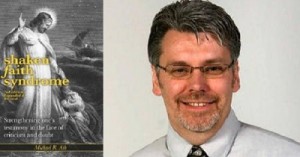 The following series of articles is a fictional dialogue between Shane and Doug, two former missionary companions many years after their missions. Shane writes to his friend Doug who has posted comments about his on-going faith crisis on Facebook. The characters are fictionalized composites of members who have faced these same dilemmas but the issues are based on very real problems which have caused some to stumble. Likewise, the responding arguments are based on the author’s own personal engagement with these same concerns as well as his discussion of these issues with other members who have struggled. (By Michael R. Ash, author of Shaken Faith Syndrome: Strengthening One’s Testimony in the Face of Criticism and Doubt, and Of Faith and Reason: 80 Evidences Supporting the Prophet Joseph Smith, and Director of Media Products for FairMormon.)
The following series of articles is a fictional dialogue between Shane and Doug, two former missionary companions many years after their missions. Shane writes to his friend Doug who has posted comments about his on-going faith crisis on Facebook. The characters are fictionalized composites of members who have faced these same dilemmas but the issues are based on very real problems which have caused some to stumble. Likewise, the responding arguments are based on the author’s own personal engagement with these same concerns as well as his discussion of these issues with other members who have struggled. (By Michael R. Ash, author of Shaken Faith Syndrome: Strengthening One’s Testimony in the Face of Criticism and Doubt, and Of Faith and Reason: 80 Evidences Supporting the Prophet Joseph Smith, and Director of Media Products for FairMormon.)
Dear Doug,
I haven’t heard from you since my last letter discussing Joseph Smith’s hesitancy to talk about his First Vision. I hope all is well. As promised, this letter hopes to address your concerns with the fact that Joseph wrote or dictated various accounts of the First Vision. From your previous letter it appears that you were surprised to find out that there were variant renditions of the vision. You quoted, in fact, one critic who claims that the Church has tried to “cover up” the fact that these differing accounts exist. The truth is, Doug, that the various versions have actually been discussed in the official Church magazines such as the Improvement Era in 1970 and again in the Ensign in 1985 and 1996.
LDS scholars have known about the different versions for many years and the Church has attempt to publicly acknowledge and discuss those versions for more than forty years—long before there was the Internet, which, as critics often claim, is the impetus which has “exposed” these supposed difficulties.
The real concern isn’t about “covering up” the fact that these different accounts exist, but rather what we make of the fact—acknowledged for decades by believing LDS scholars—that there are discrepancies between the accounts. This particular issue is one that really had no impact on me during my own faith-crisis. I remember having read one of the Ensign articles that discussed the different accounts of the First Vision so it didn’t catch me off guard when I read about it in anti-LDS literature.
I know the point of the critics is that Joseph Smith supposedly evolved his story as he got older—which suggests that the story is made-up—but I never found this argument to be that impressive. Who doesn’t tell about an event different at different stages in one’s life or depending on the listening audience?
When I was about 10 my 8 year-old little brother got out the ladder and climbed on the roof in the hopes of “parachuting” off with a bed sheet. The sheet got stuck on the roof antenna and he dangled precariously over the ledge of a two-story drop. My mom came to the rescue, climbed the ladder and pulled him in back to the roof. It was a fun story I told for many years about my crazy little brother. It wasn’t until I was in college that I discovered that my mom was deathly afraid of heights. I never knew it before. My mom told how she really struggled to get up on the roof and prayed for strength. She worried that if she ran to get a neighbor or called the fire department, the sheet might rip and my brother would fall to the ground, so she knew she had to move fast.
When I tell the story to my own kids the event is the same, but the story and emphasis I tell is different than the way I told the story in my pre-college years. Changing the details in hindsight doesn’t mean I’ve fabricated the story, I just know more now than I did then so my story includes the wisdom that has been added.
Most of the so-called “discrepancies” between the various accounts are of little importance and can easily be resolved by additional insight that Joseph received following the vision as well as the audience to whom the accounts were written. I’ll bet you don’t tell the First Vision story exactly the same—with every nuance and emphasis—when you talk to your High Priest group as you did when you were telling an investigator while we were on our missions.
The three biggest potential problems with the differing accounts are: 1) Joseph’s age is inconsistent in the differing accounts: 2) according to many critics there was no 1820 revival (which Joseph claimed was the reason he sought the Lord in prayer), and: 3) in the first known record (1832) Joseph only mentioned seeing Christ rather than seeing both the Father and the Son. So let’s look three issues.
Joseph’s Age at the First Vision
From 1828 to 1831 Joseph began collecting, compiling, and attempting to preserve Church documents—the first of which was his revelations. Later he began gathering other documents such as minute books. By 1832 he began documenting the details of his personal life and history. This 1832 record was penned primarily by Joseph himself, although some parts were written by Joseph’s scribe Fredrick G. Williams. Although the 1832 history was an unpolished draft and was never printed, it contains the earliest known account of Joseph’s First Vision.
This 1832 account claims that Joseph was in his sixteenth year when he experienced the vision (this would mean that he was 15 years old—in our first year of life we are less than 1 year old, in our second year of life we are 1 year old, etc.). In the official 1838 account, however, Joseph says that the vision happened in his fifteenth year (or when he was 14 years old). Why the discrepancy?
First, the “sixteenth” year in the 1832 account is not in Joseph’s handwriting but in Williams handwriting and is inserted between two normal lines of text. Obviously, Joseph’s age was added after Joseph first penned the account. It’s possible that Williams got the age wrong, but it’s also possible that Joseph Smith couldn’t immediately remember the year when the theophany took place.
I know I’ve had times when memory has failed me. Without my wife’s help I can’t accurately remember which year we first went to Disneyland, when I experienced my first kiss, or when my tent got flooded at Boy Scout camp. When Joseph initially experienced the First Vision he had no idea that this was the first in a series of events that would ultimately lead to the restoration. That connection wouldn’t be made until years later when Joseph could look back on the past with the benefit of hindsight. Under such circumstances he may not have made a mental note regarding the year or month when the vision occurred, and years later he would have been forced to calculate or estimate backwards in order to recover the correct date—the same as I have done on numerous occasions.
Joseph’s recital of his childhood memories indicate that he was just like the rest of us when it came to recalling things from our past. The further back in the past, the more likely he was to estimate his age with qualifiers such as “about.” In fact, in his official (and published) 1838 history he said that his brother Alvin died in 1824. Four years later, however, he discovered that he was mistaken and he corrected the history to reflect the correct year of Alvin’s death at 1823.
No 1820 Revival
A number of critics have argued (and you cited some of these in your previous letter) that, contrary to Joseph’s 1838 First Vision recital, there was no religious revival in Palmyra in 1820. First, it’s important to point out that Joseph didn’t claim there was an 1820 “revival” but that there was an “unusual excitement on the subject of religion” in the vicinity preceding his plea for the Lord’s guidance. The fact is, however, that newspaper articles, letters, and other writings by non-Mormons of the day, support exactly what Joseph Smith claimed. There were a number of religious camp meetings and revivals in the area surrounding the Smith’s home during, and just prior to, 1820. The critics are flat our wrong in their argument—which is demonstrated by current research and documentation.
One Personage Instead of Two
As you note in your previous email, the critics claim that the story of the First Vision evolved into a more complicated tale as time passed by. Prior to 1835, they argue, Joseph claimed to have only seen one personage in his vision (unlike the appearance of the Father and the Son which we read about in the 1835 account).
Joseph wrote his 1832 account as an unpolished and unpublished brief personal biography in which the focus of the First Vision recital was his personal standing before the Lord. The 1835 account was transcribed by Joseph’s scribe Warren Parish when Joseph recounted the experience to a non-Mormon visitor. In this account Joseph shared the detail that both the Father and Son appeared in his vision.
When we examine the letters and journals of those who knew Joseph prior to 1835 we find that as early as 1832 some members were aware that Joseph was visited by two personages in his First Vision. The fact that Joseph didn’t mention the Father and the Son in his rough 1832 account doesn’t indicate that he made up the story, but rather than the focus of recital was different than the 1835 account in which he shared a more detail with a non-member who was curious about the events leading up to the Restoration.
The fact of the matter is, that all of Joseph’s accounts of the First Vision are harmonious on the important points—Joseph’s disillusionment with the churches of his day, his search for religious truth, his prayer for guidance, the fact that God answer’s prayers, and the appearance of deity in response to his supplication.
While Joseph may not have initially understood the worldwide significance of his First Vision, in time he was able to see that the hand of God was already in play from his early childhood, through his adolescent years, and into adulthood as the Lord prepared him to become an instrument in the Restoration of Christ’s Church on Earth.
Your friend,
Shane
Letters to a Former Missionary Companion – Letter 1
Letters to a Former Missionary Companion – Letter 2


